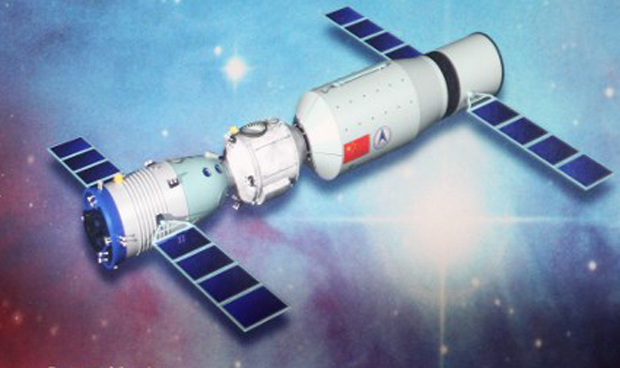‘Out of control’ Chinese space lab to meet fiery end within hours

Tiangong-1 with the Shenzhou-9 spacecraft. AFP
BEIJING, China — An abandoned Chinese space laboratory is set to meet a fiery end within hours as it re-enters Earth’s atmosphere, hitting a speed of around 26,000 kilometers an hour before disintegrating.
The European Space Agency forecast that China’s defunct Tiangong-1 craft would come down during “a window of about four hours… centered on 01:07 UTC (GMT)” on Monday.
The agency said in a blog post Sunday that this was its “final estimate” because it is “at the limit of what we can forecast”.
The China Manned Space Engineering Office had said earlier Sunday that the abandoned orbital outpost would make its earthbound plunge on Monday.
The eight-ton craft is unlikely to cause any damage when it comes down, but its fiery disintegration will offer a “splendid” show akin to a meteor shower, Chinese authorities said previously.
Debris from the lab could land anywhere between the latitudes of 43 degrees north and 43 degrees south — from America’s Midwest to New Zealand, the ESA has said.
“The high speeds of returning satellites mean they can travel thousands of kilometers during that time window, and that makes it very hard to predict a precise location of reentry,” said Holger Krag, head of the ESA’s Space Debris Office, in comments posted on the agency’s website.
The ESA added, however, that the space lab will likely break up over water, which covers most of the planet’s surface. And it described the probability of someone being hit by a piece of debris from Tiangong-1 as “10 million times smaller than the yearly chance of being hit by lightning”.
There is “no need for people to worry”, the China Manned Space Engineering Office said earlier on its WeChat social media account.
Such falling spacecraft do “not crash into the Earth fiercely like in sci-fi movies, but turn into a splendid (meteor shower) and move across the beautiful starry sky as they race towards the Earth”, it said.
Tiangong-1 — or “Heavenly Palace” — was placed in orbit in September 2011, an important step in China’s efforts towards building its own space station.
The module — which was used to practise complicated manual and automatic docking techniques — was originally intended to be used for just two years, but ended up serving considerably longer.
During its brief lifespan, it hosted Chinese astronauts on several occasions as they performed experiments and even taught a class that was broadcast into schools across the country.
Out of control?
Tiangong-1 had been slated for a controlled re-entry, but ceased functioning in March 2016. Space enthusiasts have been bracing for its return ever since.
The ESA has said that ground controllers were no longer able to command Tiangong-1 to fire its on-board engines, which could have been used to control where it re-entered Earth’s atmosphere.
In contrast, Russia brought down its massive Mir space station through a controlled re-entry over the Pacific Ocean in 2001.
A Chinese spaceflight engineer denied earlier this year that the lab was out of control.
Chinese media have downplayed comments by the ESA and others that the country’s engineers have lost control of the lab, with reports saying that the idea it is “out of control” is an invention of foreign media.
But on Chinese social media, commenters criticized the government’s reluctance to own up to the situation.
“Can you or can’t you report that you’ve lost control of the situation?” one person wrote on the Twitter-like Weibo.
“It’s not unusual that something this complicated would have a mishap.”
Beijing began its manned spaceflight program in 1990 after buying Russian technology that enabled it to become the third country with the ability to launch humans into space, following the former Soviet Union and the United States.
China sent another space lab, Tiangong-2, into orbit in September 2016 as a stepping stone to its goal of having a crewed space station by 2022.
It also plans to send a manned mission to the moon in the future. /cbb














